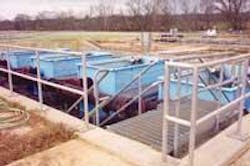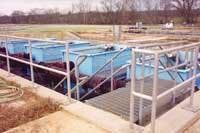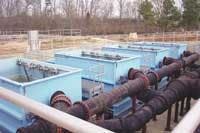Installation of Tertiary Filter System Meets Increased Water Demands
By Marvin Hammond
In recent years, the Halls Crossroads community in East Tennessee has experienced a prosperous growth spurt of economic development. While the growth meant good things to the utility district serving this area, it also presented some very real challenges for the district's wastewater treatment facility that was operating at capacity before the growth spurt began.
The Hallsdale-Powell Utility District (HPUD) recognized early symptoms and took immediate action. A pilot study was the first step in determining available options for better processing its wastewater, while allowing for current community growth as well as further expansion.
After weighing a variety of options, HPUD decided that the process and technology provided by the AquaDisk Filter, an Aqua-Aerobic tertiary filter system, would meet its supply/demand challenge.
Growing Demand
With state-ranked schools, access to major interstates, large selections of retail and restaurants and strong ties to civic and professional organizations, North Knox County is an ideal place to work, live and play. As one of the fastest growing areas of East Tennessee, the community has seen in recent years a booming growth in business and residential development.
Serving a customer base of 23,000, HPUD was already at its maximum capacity, processing eight million gallons of wastewater per day. With projected growth at 15 to 20 percent a year, HPUD clearly needed to increase its wastewater treatment capacity, but this also meant increasing the amount of solid effluent emptied into its main water source, Beaver Creek.
Preserving the aquatic life of Beaver Creek, which runs alongside the treatment plant, was a high priority because many homes are built along the tributary due to its beauty and aquatic life habitat. The creek had just been placed on an Environmental Protection Agency (EPA) list of streams that were at risk of becoming endangered, and the amount of solids discharged into the stream could not be increased.
This challenge of maximum capacity and maximum output meant the plant's future would be hindered within five to seven years if dramatic changes to the facility's infrastructure were not made.
In early 1999, HPUD took action by initiating a pilot study to determine how to better process its wastewater to meet the explosive community growth. The study resolved that it was imperative to upgrade the wastewater treatment plant to a capacity of 12 mgd.
Tertiary Filter System
Research evaluated three options that would allow the utility to meet growth under the EPA's restrictions. The option of piping the effluent to a less restrictive water source or building a new treatment plant would be very costly and would cause disruption to communities surrounding any new construction. On-site solutions considered included installing either a sand filter system or an Aqua-Aerobic tertiary filter system with an AquaDisk Filter.
The study found that using a cloth-membrane as the filter media allowed the tertiary filter system to consistently remove very fine solids. As opposed to the conventional sand filter, the AquaDisk system was able to produce higher quality effluents and provide continuous filtration during backwash, with lower backwash rates. With its vertical orientation of the filter media, the system provided a large amount of filter area in a smaller footprint.
After considering these options, HPUD decided that the tertiary filter system proved to be the most effective option due to its ease of use and ability to add additional units for necessary future plant expansions.
The recommendations from the study were sent to the Tennessee Department of Environmental Conservation (TDEC) in June 1999 for installation approval. The proposed project was unusual, as only one other tertiary filter system had ever been installed in Tennessee at the time.
Since this installation was a new concept, the burden of proving its effectiveness was high. The study was able to successfully demonstrate that this process, compared to wastewater treatment previously at HPUD, allows for a much higher level of filtration. After reviewing these results, the TDEC approved the project in early September. The upgrade plans were set, and the installation was completed on October 31, 2000 — on time and at a cost of $1.7 million.
High Water Marks
Improvements provided by these upgrades at HPUD have added to the quality of life in the communities it serves, because now the water coming out of Beaver Creek is better than its native quality. Acting as a good steward of resources, the goal of the utility was to make new community growth possible without choking out the aquatic life of existing water sources. This has been accomplished, while providing ratepayers with the highest value possible.
The treatment capacity has been increased by 25 percent, to 12 mgd, enabling the utility to keep pace with aggressive growth. When the utility expands in the future, the system will be able to reach a capacity of 20 mgd.
The effluent solids content has dropped from 300 to 400 pounds per day to 50 to 60 pounds. The filter has already decreased the amount of biochemical oxygen demand by 31 percent and has allowed HPUD to meet all EPA guidelines by reducing the amount of wastewater solids by 83 percent.
In large, these improvements have allowed the district to expand services into new areas that were previously without public water service.
Outside praise has come from the upgrade project as well. HPUD is the first district in the state to be recognized for its water-resource management practices by The Tennessee Conservation League, which has awarded the utility with the "2002 Water Conservationist of the Year Award," for the prevention of water quality degradation and improving water standards. The utility has also received an "Award of Merit" from The Rebuild Tennessee Coalition.
The underlying concern for HPUD throughout this upgrade project, and with every decision it makes, is what will be in the best interest for the community it serves. The installation of this tertiary filter system is just one way the utility has successfully positioned itself as a modern, progressive utility district.
About the Author: Marvin Hammond is the chief executive officer and president of HPUD. Hammond is highly committed to environmental stewardship and encourages his employees to be involved in these efforts. Currently, 40 percent of his 100 employees are participating in volunteer environmental efforts. Hammond runs the third largest utility district in the state of Tennessee, providing water and wastewater services to over 23,000 customers.


